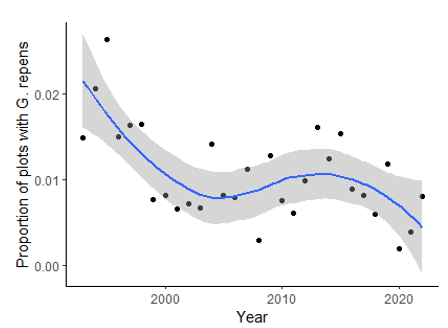The data from the National Forest Inventory consisted of values from 29 356 separate inventories. Goodyera repens was observed a total of 331 times, meaning that the species was present in 1.13% of the inventories. The number of permanent plots from which data was received was 12 147, in which G. repens was present in 264 of these, or in 2.17%. The trend of G. repens over the years 1993 to 2022 was negative, meaning that the number of places where G. repens occurs has been declining. The explanatory effect of year on the response variable, occurrence of G. repens has a p-value lower than < 0.001, and an AIC value that is 26.6 lower than that of the null model. The first three years (1993:1995), the mean proportion of occupied plots was 0.021, in comparison the mean proportion of occupied plots the last three years (2020:2022) was 0.005.

The trend of G. repens between the years 1993 and 2023. The points represent the proportion of plots with G. repens each year. The blue smoothed line represents the trend using a logically weighted scatterplot smoothing method, and the shaded grey represents its 95% confidence interval.
After removing missing data, the NFI analysis covered 28,405 inventories. G. repens was present in 1.15% of inventories and 2.18% of 11,961 permanent plots. Occurrence increased with stand age, basal area, number of moss species, and in conifer-dominated plots with gaps. Basal area and moss species were the most important variables.
Of 206 observations, G. repens went extinct in 155 plots (75.2% risk). Extinction probability increased with basal area change and ground inclination, but decreased with moss species and fewer gaps. Of 16,238 plots, colonization occurred in 114 (0.7%). Colonization probability increased with basal area, stand age, and species richness of mosses, herbs, and trees. Several variables, such as basal area, stand age, and field layer, showed a mismatch between sample plot distribution and G. repens occurrence.

A map showing Östergötland county. The raster shows the predicted occurrence probability of G. repens and the points are the locations used in the glmn, blue are sampled locations and pink are reported observations of G. repens.
Of 6,714 plots, G. repens was present in 1.19%. Occurrence probability increased with basal area and connectivity, and decreased with soil moisture according to the analysis based on open geodata. Predicted occurrence probability of the orchid in Östergötland ranged from near 0 to 0.9. G. The mean predicted probability was 0.042 in known locations and 0.011 in sampled locations.